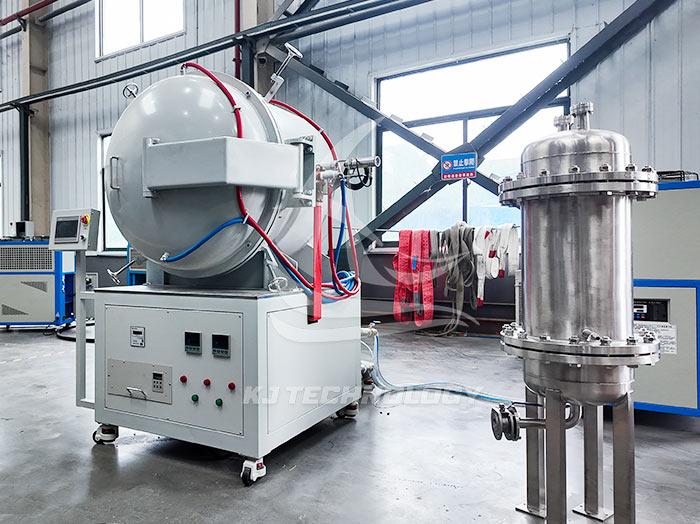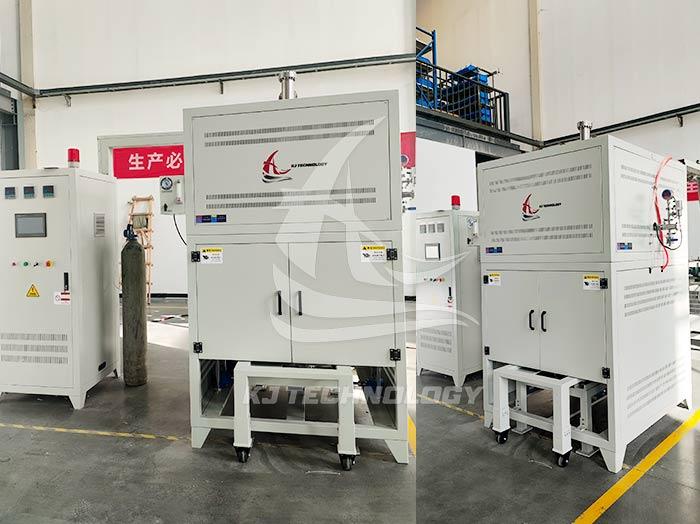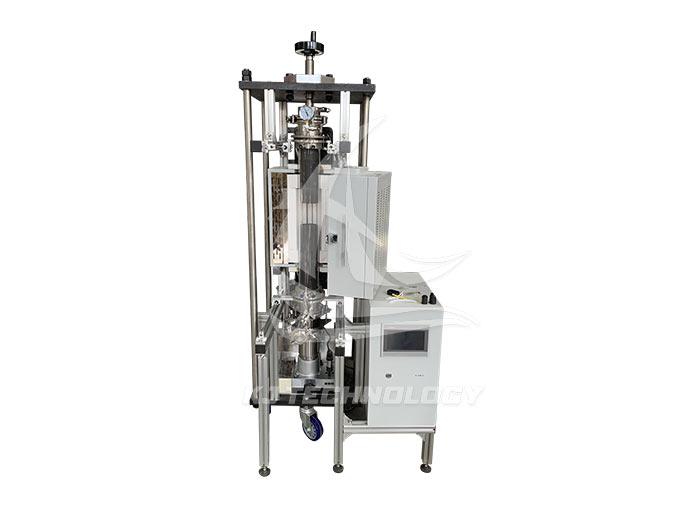Experimental vacuum hot press furnace
 09-22-2025 Author: KJ technology
09-22-2025 Author: KJ technology
Experimental vacuum hot press furnace is an experimental equipment that applies pressure to materials under high temperature, vacuum (or protective atmosphere) conditions to achieve hot press molding. It is widely used in materials science, metallurgical engineering, chemical engineering and other fields. The following provides a detailed introduction from five aspects: device principle, structural composition, application fields, operation points, and development trends:
1. Equipment principle
The vacuum hot press furnace promotes material densification through the synergistic effect of high temperature and mechanical pressure. At high temperatures, the solid particles in the raw material are bonded to each other, the grain size grows, the voids and grain boundaries decrease, and volume shrinkage and density increase are achieved through material transfer, ultimately forming a dense polycrystalline sintered body. This process can reduce the sintering temperature (about 200-400 ℃), shorten the sintering time, and effectively suppress grain growth, especially suitable for the preparation of difficult to machine materials such as nanomaterials, high melting point metals, and ceramics.
2. Structural composition
The vacuum hot press furnace is mainly composed of the following systems:
Furnace body: Vertical double-layer water sandwich structure, with stainless steel cylinder on the inner layer and carbon steel on the outer layer. The furnace wall temperature is controlled by circulating cooling water (≤ 60 ℃). The furnace cover can be manually opened on the side for easy operation.
Heating system: using graphite or molybdenum sheet resistance heating to ensure temperature uniformity inside the furnace.
Vacuum system: composed of oil diffusion pump, Roots pump, mechanical pump, and electromagnetic pressure differential valve, it can achieve high vacuum environment (≤ 10 ⁻ ³ Pa) to prevent material oxidation.
Pressurization system: The hydraulic cylinder drives the pressure head to pressurize up and down, with a pressure range of usually 0-100 MPa, and supports pressure stabilization and maintenance functions.
Temperature measurement system: Platinum rhodium thermocouple or infrared thermometer can monitor temperature in real-time with an accuracy of ± 1 ℃.
Inflating system: can be filled with protective gases such as nitrogen and argon, supporting atmosphere sintering.
Water cooling system: ensuring the safe operation of equipment, equipped with water cut-off sound and light alarm and automatic heating cut-off function.
Control system: using PID instruments or PLC touch screens, supporting automatic adjustment and historical data recording of parameters such as temperature, pressure, and vacuum degree.
3. Application Fields
Hard alloys, such as tungsten carbide and titanium alloys, are sintered by hot pressing to increase their density and hardness.
Functional ceramics, such as silicon carbide, silicon nitride, transparent ceramics, etc., achieve rapid densification at low temperatures.
Powder metallurgy: preparation of composite materials such as metal ceramics and powder high-speed steel.
Nanomaterials: Inhibit grain growth during sintering process and obtain nanocrystalline structure.
Diffusion welding: used for connecting dissimilar materials such as ceramic metal and metal metal.
Target preparation: such as ITO target, magnetron sputtering target, etc., to achieve large-sized and high-density molding.
4. Operation points
preparation:
Check if all components of the equipment (heating element, temperature measuring element, vacuum system) are intact.
Clean the furnace chamber to avoid impurities contaminating the sample.
Confirm that the power, water, and gas connections are normal.
Sample placement:
Place the sample in the center of the furnace cavity to avoid direct contact with the heating element.
Close the furnace door and check the sealing.
Vacuum pumping and inflation:
Start the mechanical pump, Roots pump, and diffusion pump in sequence, and gradually evacuate to the target value.
To protect the atmosphere, fill it with gas after the vacuum degree meets the standard.
Heating and pressurization:
Set the heating rate, sintering temperature, and holding time.
After reaching the sintering temperature, start the pressurization system and control the pressure magnitude and duration.
Cooling and Sampling:
After the insulation is completed, turn off the heating system and let it cool naturally to room temperature.
Maintain a vacuum state (if necessary) and open the furnace door for sampling after the furnace temperature drops to a safe range.
5. Development Trends
Efficient and energy-saving: adopting a one to two design (such as Haoyue Technology products), a control system controls the dual furnace body, reducing the footprint and cost.
Intelligent control: integrating PLC touch screen and IT technology to achieve remote monitoring and automatic data analysis.
Multi functional integration: Combining various sintering methods such as hot pressing, air pressure, and hot isostatic pressing to expand the application range.
Green Manufacturing: Optimize furnace structure and heating methods, reduce energy consumption, and decrease carbon emissions.








